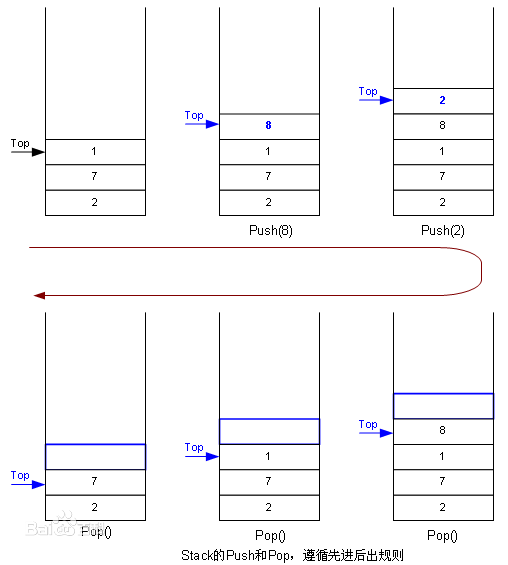栈是一种只允许在一端进行插入或删除操作的线性表.其特点为:先进后出(FILO)/后进先出(LIFO);
栈 VS. 队列
栈和队列都是动态集合, 但在栈中, 可以去掉的是最近插入的那一个,:栈实现了一种后进先出(last-in, first-out)的策略;类似的, 在队列中, 可以去掉的元素总是在集合中存在时间最长的那一个:队列实现了先进先出(first-in, first-out)的策略[下一篇我们着重复习队列].
栈的示意图:

//顺序栈的实现与解析
template <typename Type>
class MyStack
{
template <typename T>
friend ostream &operator<<(std::ostream &os, const MyStack<T> &stack);
public:
MyStack(int stackCapacity = 16);
~MyStack();
bool isEmpty() const;
void push(const Type &item);
void pop() throw (std::range_error);
const Type &top() const throw(std::range_error);
private:
Type *m_stack;
int m_top;
int m_capacity;
};
template <typename Type>
MyStack<Type>::MyStack(int stackCapacity):m_capacity(stackCapacity)
{
if (m_capacity < 1)
throw std::range_error("new size must >= 1");
//申请内存并构造对象
m_stack = new Type[m_capacity];
if (m_stack == NULL)
throw std::bad_alloc();
m_top = -1;
}
template <typename Type>
MyStack<Type>::~MyStack()
{
//析构对象并释放内存
delete []m_stack;
m_stack = NULL;
m_top = -1; //将top指针指向无效
m_capacity = 0;
}
//全局函数:数组放大/缩小
template <typename Type>
static void changeSize1D(Type *&array, int oldSize, int newSize)
throw (std::range_error, std::bad_alloc)
{
if (newSize < 0)
throw std::range_error("new size must >= 0");
Type *tmp = new Type[newSize];
if (tmp == NULL)
throw std::bad_alloc();
int minSize = std::min(oldSize, newSize);
std::copy(array, array+minSize, tmp);
delete []array; //将原数组释放掉
array = tmp; //将原指针指向新申请的数组
}
template <typename Type>
void MyStack<Type>::push(const Type &item)
{
//数组最大容量为m_capacity, 因此数组的最大下标为m_capacity-1
if (m_top >= m_capacity-1)
{
changeSize1D(m_stack, m_capacity, m_capacity * 2); //一次扩容2倍
m_capacity *= 2;
}
//将元素插入栈顶
m_stack[++ m_top] = item;
}
//栈是否为空
template <typename Type>
inline bool MyStack<Type>::isEmpty() const
{
return -1 == m_top;
}
template <typename Type>
inline const Type &MyStack<Type>::top() const
throw (std::range_error)
{
if (isEmpty())
throw std::range_error("stack is empty");
return m_stack[m_top]; //返回栈顶元素
}
template <typename Type>
inline void MyStack<Type>::pop()
throw (std::range_error)
{
if (isEmpty())
throw std::range_error("stack is empty");
//注意:如果该栈保存的对象类型的元素, 则需要显示调用其析构函数,
//同时还需要将栈顶指针下移
m_stack[m_top --].~Type();
}
//输出栈的所有内容,以便测试
template <typename Type>
ostream &operator<<(ostream &os, const MyStack<Type> &stack)
{
os << stack.m_stack[0];
for (int i = 1; i <= stack.m_top; ++i)
os << ' ' << stack.m_stack[i];
return os;
}
附-测试代码
int main()
{
MyStack<int> iStack;
iStack.push(10);
iStack.push(22);
iStack.push(15);
cout << iStack << endl;
try
{
cout << "Top = " << iStack.top() << endl;
iStack.pop();
cout << "Top = " << iStack.top() << endl;
iStack.pop();
cout << "Top = " << iStack.top() << endl;
iStack.pop();
cout << "Top = " << iStack.top() << endl;
}
catch (const std::exception &e)
{
cout << e.what() << endl;
}
}
